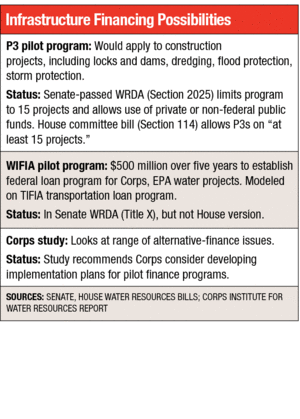
As a new Water Resources Development Act, or WRDA, chugs ahead on Capitol Hill, it's looking more likely that Congress will give the Corps of Engineers a go-ahead to use innovative financing techniques on water infrastructure projects.
In addition, on its own, the Corps is in the early stages of investigating how it might add to its financing toolbox.
The WRDA that the Senate approved in May and the version the House Transportation and Infrastructure Committee cleared on Sept. 19 both would expand the Corps' ability to use public-private partnerships (P3s). The Senate bill limits the program to 15 projects and allows them to draw on Corps funds, state or local public funds or private dollars.The House committee measure authorizes P3s on "at least 15 projects."
House committee member Cheri Bustos (D-Ill.) said at the panel's voting session that some Corps facilities, such as Mississippi River locks and dams, are nearly 80 years old. Letting the Corps do P3s, she said, would "help clear the estimated $60 billion in outstanding projects that would take, literally, decades to complete without this outside investment."
The Senate WRDA would go further by creating a federal loan program for Corps and Environmental Protection Agency water projects. The bill would authorize $100 million a year over five years for a Water Infrastructure Finance and Innovation Act program (WIFIA). That $500 million in direct federal aid would support about $5 billion in loans. It is modeled on the popular, 15-year-old Transportation Infrastructure Finance and Innovation Act (TIFIA). But WIFIA is not in the House committee's bill.
John Doyle, special counsel with Jones Walker LLP, a law and lobbying firm, says, "Nobody that I know expects in the near term—and maybe even in the long term—that the skies are going to open and ... dollars are going to fall from heaven, at least from the federal heaven." Doyle adds, "The choices are [to] continue to just bump along at clearly insufficient funding levels or look to find other sources of funding to get done work that needs to be done."
In-House Study
Meanwhile, the Corps itself is exploring innovative financing as part of a wide-ranging civil-works "transformation" effort, says Jim Hannon, Corps headquarters operations and regulatory chief.
A Corps Institute for Water Resources report, released in June, recommends the Corps consider developing implementation plans for pilot financing programs. Hannon says, "Now, we really have to start working the details of what we have in our portfolio ... look at what authorities we have or don't have, and how would we begin to move forward."


Post a comment to this article
Report Abusive Comment